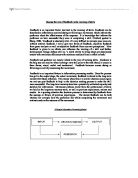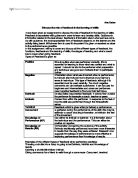A Simple Information Processing Model
A Complex Information Processing Model
We use our senses to take in information. The three main senses used during sport are vision, audition and proprioception, which is where we use our tactile sense to feel the position of our body.
The stimulus-response bond shows how the physical problem (stimulus) and the performance (response) are linked. If the performance is successful it will repeated and reinforce the S-R bond. If the performance is unsuccessful the S-R bond will be weakened and an alternative response is attempted. The stimulus-response bond suggests that positive feedback is more productive than negative feedback. However information processing models show feedback as an error detection system. Also it is well known that constructive criticism is a way of learning from your mistakes. Therefore this shows it is important to balance positive and negative feedback when coaching to enhance skills.
Feedback affects the learning of skills as the individual can compare their performance with the perfect model and make alterations to improve. Feedback, especially positive, is a form of motivation to encourage the performer. It also reinforces correct movements so the individual can repeat successful skills. Feedback also supplies knowledge and also encourages kinaesthetic sense so the performer can learn and develop new skills. There are many different forms of feedback which can be used depending on the individual and what activity they are participating in. The eight categories of feedback are;
- Positive
- Negative
- Intrinsic
- Extrinsic
- Terminal
- Concurrent
- Knowledge of performance
- Knowledge of results
Positive feedback occurs when a performance was completed correctly and successfully so therefore the performer knows what to repeat. The positive feedback is stored in the long-term memory so in future situations the player can use this experience in the decision making process as it was successful before. Positive feedback is effective when aimed at performers at the cognitive stages of learning as this helps them develop skills and is also a form of motivation. It is necessary to always give correct feedback to prevent the performer repeating mistakes in a similar sporting situation. In individual games the coach would need to provide more positive feedback than in team games, as the performer doesn’t have the rest of the team to encourage and support them.
Negative feedback outlines what is incorrect about a performance and how to correct this. Negative feedback provides the performer with the knowledge of what not to repeat in similar situations, which can be used in the input stages of the information processing model. This form of feedback is more ideally suited to a performer at the autonomous stage of learning. This is because they can use this information constructively to improve their performance. Too much negative feedback towards cognitive learners could de-motivate them.
Intrinsic feedback is continuous and comes from within the performer, the proprioceptors are used to provide the information on the body’s position. Intrinsic feedback is also better suited to the autonomous learner, rather than a cognitive learner, as they have more experience, therefore have developed a good kinaesthetic awareness in sport to be able to feel if a skill is successful. The performer can compare the kinaesthetic sense to previous experiences and will remember whether the performance as successful or not. This will aid the decision making process.
Extrinsic feedback comes from outside sources such as a coach or peers and also includes sound and vision. Cognitive performers rely on extrinsic feedback especially visual, as they don’t have enough experience to make effective use of intrinsic feedback. Coaches and teachers should provide frequent feedback to beginners however as their skills develop and advance the amount of extrinsic feedback should decrease to encourage intrinsic feedback and a good kinaesthetic sense. In individual or racket games it is more likely this type of feedback will come from the coach or from watching a video whereas in team games it can also come from team players.
Terminal feedback occurs succeeding a performance for example after a basketball match whereas concurrent feedback is provided during a performance, this can be received either intrinsically such as the feel of a skill or extrinsically for example the coach shouting instructions from the side lines. This experience and outcome will be stored in the long-term memory to help in following decisions.
The last two types of feedback, knowledge or performance and knowledge of results are seen to be the most important and influential in the learning of skills. Knowledge of performance is information concerning the actual performance and technique. This can be either extrinsic or intrinsic. This is useful for autonomous performers as they can compare their performance with the perfect model and will help to develop kinaesthetic sense. They can analyse their performance and repeat correct skills again.
Knowledge of results is results given to the performer, which can be analysed and compared to previous performances. It is information regarding the end result, for example the final score of a football match. The feedback can be stored and later used in similar situations. However it is not as useful as knowledge of performance as the player may not have a correct memory of how they achieved the results. This is more beneficial to a cognitive learner as they can see the outcome and result.
The graph below shows that although feedback does have an influential affect on performance, feedback alone cannot completely improve performance. When a performer sets goals as well as receives feedback the level of performance increases significantly. Goal setting is important because it reduces uncertainty, confidence increased, learning is focused and feedback is specific.
All individuals have different personalities which may affect the learning of skills, for example extroverts are better suited to different sports than introverts and therefore more motivated to learn specific skills. Other factors such as ability and frequency of practice will also play a key role in successfulness of performance as well as differences between social backgrounds, and differences mentally and physically.
In conclusion, feedback has an important role in the learning of skills. It provides information so correction can be made and successful skills repeated, it also supplies motivation when a skill is done accurately and reinforces correct movements so they can be repeated. Feedback from can be stored in the long-term memory for future reference. There are many different forms of feedback and each can be aimed at certain individuals. However feedback is not the only factor involved in the learning of skills.






